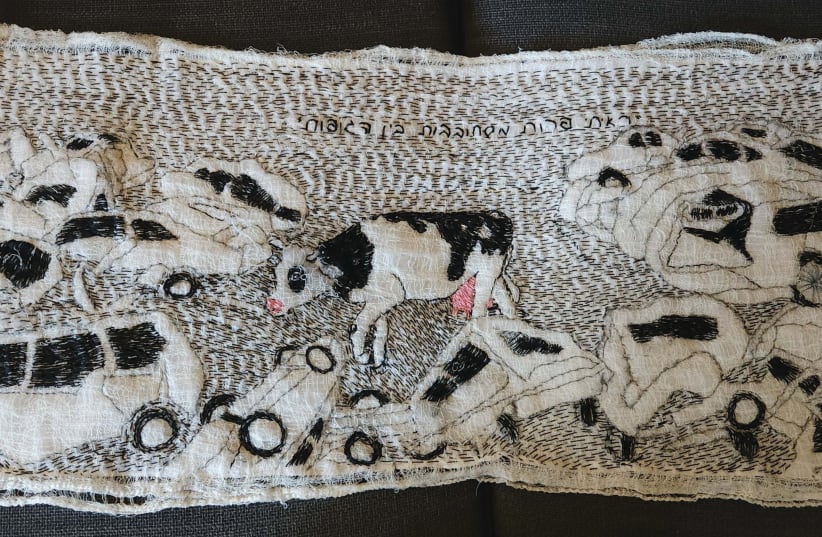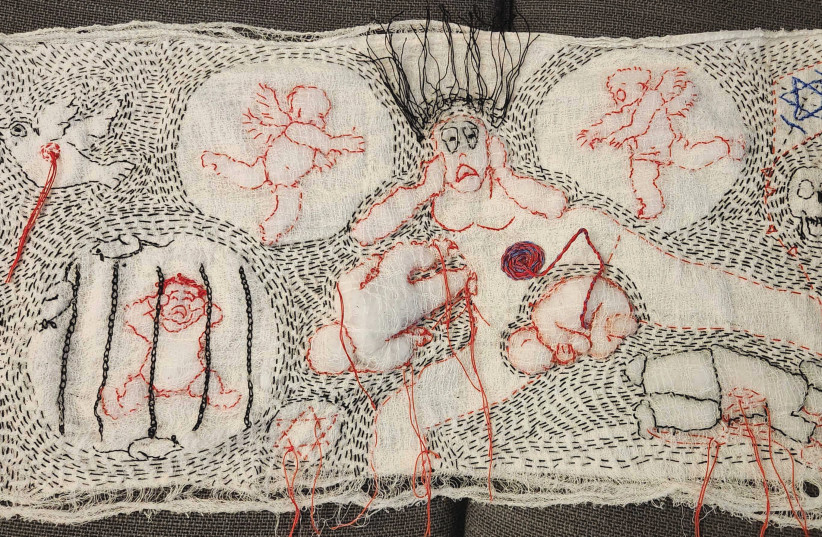Multidisciplinary artist Daniella Meller, originally from the Gaza border town of Netivot, has long used art to interact with the world around her.
Born in 1947 in Tunisia, Meller creates artwork that ranges from documenting her family’s aliyah journey when she was a child and their acclimatization to Israeli society, to depicting the shades, shapes, and shadows of nature that she sees around her.
Art captures feelings and experiences that can’t be expressed with words alone – which is why following October 7, Meller, who has friends and family across the Gaza border region and for whom the attack was deeply personal, decided to address the trauma through art.
What resulted from her efforts was a unique and personal art exhibition in Meitar, inspired by and originating from the traumatized and devastated Gaza border region.
“I know artists from all over that area, and I was in touch with them all on October 7,” recalls Meller, the mother of three and grandmother of four, who all survived the onslaught.
The terror of October 7 and the trauma shown through art
She recounts the terror of locking the doors of her Meitar residence and praying that terrorists wouldn’t enter her community and break into her home. She watched the horror of the massacre play out, in texts and WhatsApp messages, with her family and friends still living in the communities where she grew up and had spent most of her life.
“For the first two weeks following the attack, I was just glued to the TV and the news, full of fear, constantly in contact with family and friends who had lost people,” she says. “Then, on that first Sunday after two weeks of shock, I woke up feeling that I was finally ready to do something with all these terrible things that have been reaching my ears. I just needed a medium.”
Meller has worked and produced art through a variety of mediums, such as oil painting, acrylic, watercolors, and etching. For this exhibition, however, she wanted to work with something unique, with a material that would be appropriate for addressing such an immense and tragic subject, and then she remembered gauze bandages.
She discovered that – ironically – gauze, the material used to bandage so many of the wounded in the October 7 attack, originally came from Gaza (hence the similar sounding word).
“I found out that hundreds of years ago, there was a famous factory [in Gaza] that made gauze. They exported it to Europe. A doctor in Napoleon’s army saw its medical potential for bandaging, and the rest is history,” she explains.
Meller was quite familiar with gauze from her other career. In addition to her lifetime work as an artist, for many years she was the head nurse in the neurosurgery department and the emergency room at Soroka Medical Center in Beersheba. Since she had already worked extensively with gauze in other contexts, and given its history and the catastrophic circumstances, she chose embroidery on gauze as the logical, albeit unusual, medium to give a voice to the complex trauma of the South.
THE FIRST piece in Meller’s exhibition, The Cry of the Mothers, provides a visceral rendition of the horrors and emotions surrounding Hamas’s atrocities. From the murdered pregnant mother whose unborn baby Hamas tore out of its womb, to the young children kidnapped and imprisoned in Gaza, this piece touches upon the deep undercurrents of pain that Israel is suffering.
The kite with the Star of David in the top right corner, the only blue in the piece, is dedicated to the Kutz family of Kfar Aza, she explains. On Oct. 7, when the entire family – father, mother, and three children – were murdered in their home, the Kutz family had planned to fly kites over Gaza with messages of peace. It was to be part of an annual festival of coexistence that the father, Aviv, had organized. The bloodied, wounded dove with its olive branch, at the top left, expresses that shattered dream of peace.
THE SECOND piece in the exhibition, I Saw Cows Wandering among the Bodies, is based on a haunting interview that Meller heard with a reporter who toured the Gaza border region in the immediate aftermath of the attack. He recalled how in one of the devastated kibbutzim on the border, the milk cows had escaped their pens and wandered forlornly among the wreckage and devastation of the kibbutz, looking for someone to milk them.
In this piece, Meller represents the dead bodies of the victims with burnt, melted cars because that is the only image that most news channels were permitted to broadcast out of respect for the dead.
The bright, strong pink of the cow’s udder stands out against the drabness of the rest of the piece intentionally, to draw attention to the cows’ plight, she explains. The cows walked around in a panic because they desperately needed to be milked and were scared and in pain due to their full udders. Part of the goal of this piece is to capture that moment of the frightened cows wandering amid the destruction, to express the many complex layers of suffering on that terrible day.
HER THIRD piece, The Children of All of Us, is an artwork that evolves with time. “It represents each of the children who were kidnapped, from babies until age 18, with a yellow ribbon that is closed and sealed with a safety pin. The pin is opened and removed when that child is rescued or released and returned to Israel,” she says.
“Safety pins stab, much like this terrible situation stabs the heart, but the significance of the ‘safety’ is that hopefully, despite the pain, the children are, and will continue to be, safe.
“The day that each child is released, when I can finally remove their yellow ribbon, I replace it with a blue ribbon and close it by stitching on it a Star of David,” representing their freedom, she continues. If some of the victims were to perish in Gaza instead of being released, she speculates that she might replace their yellow ribbon with a black ribbon instead. Hopefully, she says, she will never have to.
“In this way, this piece is a sort of interactive work with myself,” she says. “On the day that they released eight children, I prepared eight pins; and then, when there was a delay, I had to wait in stress before taking them off and replacing them.”
For Meller, it was also important to incorporate a communal aspect to this piece. Accordingly, she diligently photographed each stage of the interactive work of art and uploaded it on her Facebook page, enabling the public to follow along and see their hopes and fears for the hostages represented through the evolution of the piece.
In each piece, Meller takes a different section of the population that was impacted by the atrocities of Oct. 7 and finds a new way to represent her subject. For The Golden Age in the Depths of the Ground in Gaza, she took the subject of kidnapped seniors from age 75 and up, her own age demographic.
Here, she represented her subjects by way of a gauze tapestry, depicting some of the senior citizens who were abducted to Gaza. For her, this piece is especially personal. “I worked in Kibbutz Nirim for around 10 years as an artist at their etching workshop, and I know and am very involved with a lot of people there. I’m friends with a lot of people in Kibbutz Nir Oz as well,” she says. Some of the people currently held in Gaza are her friends, and through this piece she hopes to honor them.
In addition to her pieces addressing Oct. 7 and the current tragedies, her exhibition includes a piece completed in 2008 that is relevant to the current situation. Using linoleum prints on cloth, the piece features the red anemone that blooms every spring in the Gaza border region. Each flower pictured represents a missile that was fired at Sderot during that difficult time.
The cloth also features red hand prints, referencing the image of the infamous photograph taken in Ramallah in 2000 during the Second Intifada, when two Israeli soldiers were lynched in the city. One of their murderers gleefully held up his bloody hands out of the window to a murderous, celebrating crowd below. In Meller’s piece, the flowers and bloodied hands come together to capture something of the tragedies that Israel has suffered in recent decades, providing a backdrop and context for the rest of the exhibition.
MANY PEOPLE have told the artist that her pieces express for them “very precisely what’s happening,” and that they give voice to what they’re experiencing and feeling. For the public to connect to her work in that way, and to feel that it expresses something deep, is exactly what Meller had hoped would happen.
Her exhibition had its debut on December 14, the last night of Hanukkah, in the Meitar community, northeast of Beersheba. At the suggestion of the exhibition’s curator, Ronit Amit Nahir, she covered the other pieces in the gallery with white mourning sheets for the duration of the exhibition instead of removing them.
What resulted is a haunting effect, whereby the sheets “joined the installation, and resembled ghosts that accompanied the sadness recorded in the [exhibition’s] works embroidered on the dressing materials,” she says.
Meller was surprised that some extended family members – an elderly couple whose soldier grandson was recently discovered to have been murdered on Oct. 7, after being considered kidnapped for about two months – attended the exhibition’s opening. Toward the end of the evening, she invited the grandfather to light the Hanukkah candles. Afterward, he spontaneously shared a few words about his grandson with the guests, who were visibly moved.
The evening concluded with the exhibition’s visitors reciting the holiday blessings and singing Hanukkah songs together. The many guests, reflects Meller, were “enveloped in an atmosphere that characterizes the difficult days we are all going through.”
To schedule a visit to Daniella Meller’s exhibition in Meitar, contact her at: daniella.meller@gmail.com.

